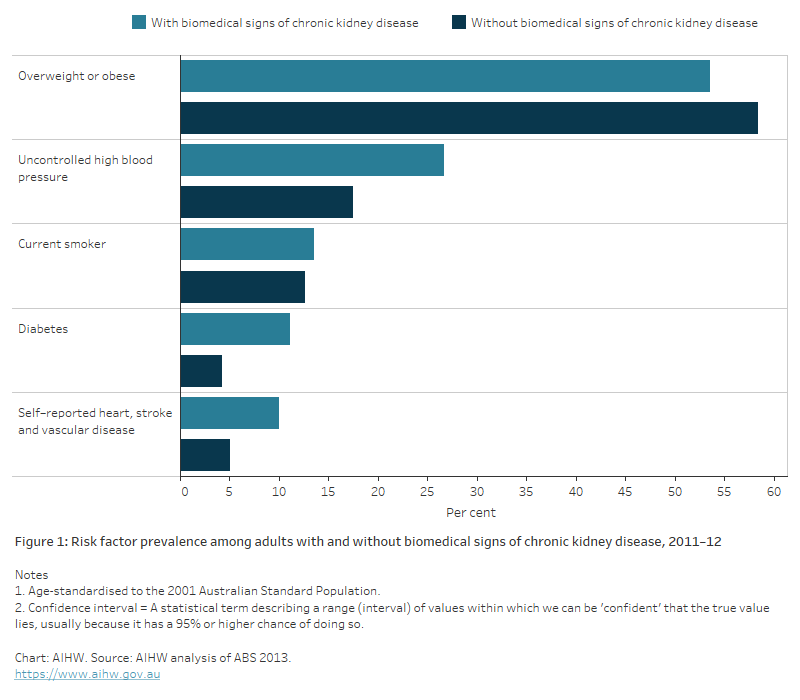Risk factors among adults with chronic kidney disease
This web page compares levels of 5 key chronic kidney disease (CKD) risk factors among adults with and without biomedical signs of CKD.
The populations with and without CKD were obtained from the 2011–12 National Health Measures Survey (NHMS) – the biomedical component of the Australian Health Survey (AHS) – which is the most recent national survey to include biomedical testing (ABS 2013).
Adults who had biomedical signs of CKD in the 2011–12 NHMS had significantly higher levels of diabetes, uncontrolled high blood pressure and self-reported heart, stroke and vascular disease, than adults who did not have biomedical signs of CKD (Figure 1).
These higher risk factor levels among adults who may have developed CKD highlight the need for secondary prevention to limit the disease’s further development and increased severity. Secondary prevention focuses on the early detection and best practice management of a disease or disorder to reduce deterioration and long-term effects. This includes identifying people at risk of ill-health through screening programs, general health examinations, as well as the identification of complications and co-morbidities.
Biomedical risk factors
After adjusting for different population age structures, an estimated:
- 11% of adults who had biomedical signs of CKD in the 2011–12 NHMS had diabetes, 2.6 times as high as the 4.2% of adults without CKD who had diabetes
- 27% of adults with biomedical signs of CKD had uncontrolled high blood pressure, 1.5 times as high as the 18% of adults without CKD who had uncontrolled high blood pressure
- 10% of adults with biomedical signs of CKD reported having heart, stroke or vascular disease, 2.0 times as high as the 5.1% of adults without CKD who reported having heart, stroke or vascular disease.
Figure 1: Risk factor prevalence among adults with and without biomedical signs of chronic kidney disease, 2011–12
The chart shows the proportion of risk factors among adults with and without biomedical signs of chronic kidney disease in in 2011–12.

Behavioural risk factors
After adjusting for different population age structures, an estimated:
- 14% of adults with biomedical signs of CKD in the 2011–12 NHMS were current smokers, similar to the 13% of adults without CKD who were current smokers
- 54% of adults with biomedical signs of CKD in the 2011–12 NHMS were overweight or obese, similar to the 58% of adults without CKD who were overweight or obese.
Although the differences in this survey were not statistically significant, smoking and overweight or obesity are considered risk factors for CKD, as well as diabetes and cardiovascular disease, which in turn are risk factors for CKD.
Further information
For more information on these and other CKD risk factors, see:
- Diabetes
- High blood pressure
- Heart, stroke and vascular disease
- Overweight and obesity: an interactive insight
- Smoking
- Insufficient physical activity
- Poor diet
- Alcohol
- Health risk factors among Indigenous Australians
- Australian Burden of Disease Study 2018: interactive data on risk factor burden
See Risk factors for more information on this topic.
References
ABS (Australian Bureau of Statistics) (2013) Microdata: Australian Health Survey, 2011–12, AIHW analysis of detailed microdata, accessed 20 October 2021.


